How to grow a backyard vegetable garden
Ferry-Morse Home Gardening Blog | 2024
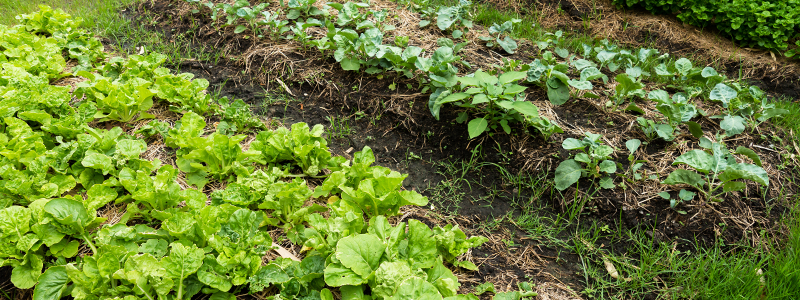
Areas of a backyard garden that have been turned into a space to grow leafy greens.
Have you ever asked yourself if you should grow your own vegetables?
Do you know that growing and consuming your own vegetables has enormous health benefits?
First of all, it’s great exercise that burns lots of calories, up to 300 per hour for light gardening chores alone!
Secondly, studies show that consuming an assortment of vegetables and fruits lowers blood pressure and reduces the risk of heart disease, stroke, some cancers, diabetes, and other health problems. Think about that for a moment.
Whether you want to try a few varieties or several, this article provides the information you need to grow a bountiful backyard vegetable garden. So, let’s get some dirt on those gloves and dig in!
What are the steps of growing a backyard vegetable garden?
Grow vegetables successfully in five simple steps:
- Create a plan.
- Choose a site.
- Prepare the garden soil.
- Plant suitable varieties.
- Nurture your plants to harvest!
Our guide on starting a backyard garden from seed covers general information. Here, we’ll focus on the particulars for vegetables.
1: Create a plan.
For vegetables especially, creating a garden plan is a worthwhile activity.
When planning, dedicate some time to consider the following:
- Will your backyard garden be a solo undertaking, or will others help maintain it?
- What vegetables do you and your family prefer?
- Do you have enough space to accommodate each plant’s growth habit?
- What varieties perform well in your geographic area?
- What are each crops’ nutrient requirements (heavy, medium, or light feeders)?
Also, give thought to organizing plants by nutrient and moisture needs, life cycle, spread, and height in relation to the sun. To illustrate, you might till soil where annuals grow, but take care to avoid tilling where perennials live. Simple, right?
[Share your garden plan with us on social! Mention or tag @ferrymorseseed or #ferrymorse on either Instagram or Facebook]
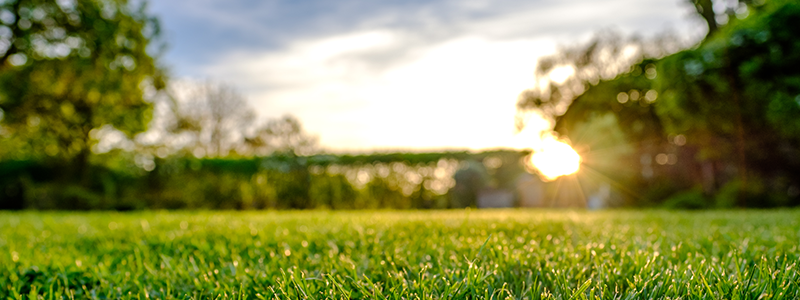
Sun shining through trees onto an open field of cut grass.
2. Choose a site.
We’ve put together the following advice points to help you select a site for your garden:
- It should receive around eight hours of sunlight per day.
- The soil should be loose and well-drained.
- If on a slope or hillside, mitigate erosion.
- Avoid low spots because cold air sinks into them, and excess water will collect there.
- Stay away from septic tanks and aerobic sprinklers.
- If strong winds are a problem, install a windbreak.
- Make sure water is easily accessible to make irrigation chores easier.
It’s important to know that your site may be any (or a combination) of the following:
- Containers
- In-ground
- Raised-bed
Do what works best for you and your situation, and you’ll be happier and more successful!
3. Prepare the garden soil.
You only need to take a few simple steps to ensure your garden’s soil can support healthy plants. A great place to start is a soil test. Learn more about interpreting the results.
Only work the soil when it’s slightly moist and crumbly. Seeds and plants won’t do well in soil wet enough to form a ball or so dry it’s clumped or powdery. It makes sense, right?
4. Plant suitable varieties.
Be sure to take advantage of your local agricultural extension office’s resources to find the best varieties. This vegetable planting guide for North Carolina is an example of the helpful information that’s available.
Also, become familiar with planting basics and transplanting vegetables. Strong plantlings tend to be high performers in the garden. Give it a go!
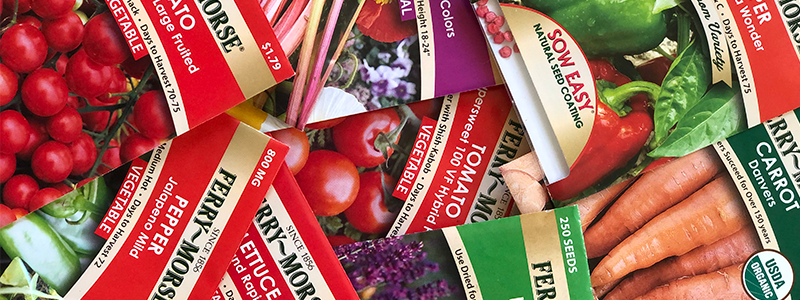
An assortment of Ferry-Morse cool and warm season vegetable seeds packets, along with some flowers and herbs.
5. Nurture your plants to harvest.
Consistent watering, fertilizing, pruning, weeding, and controlling pests increase your chances of an abundant harvest. Your plants will be happy, and so will you!
Keep reading because there’s more you need to know!
What do I need to consider before I start picking out vegetable seeds and plants?
Knowing the conditions you have to work with is essential for planting vegetables at the proper time and providing them access to sunlight, space, water, and nutrients.
Timing
Are the vegetables you want to grow cool-season or warm-season plants? Learn which vegetables belong in each category, so you know when to plant them.
Seed-starting in relation to your outdoor growing window gives seeds a chance to grow into healthy transplants indoors. Not sure if you should utilize seed starting? Check out this article on the how’s and why’s of indoor seed starting to see if it’s necessary.
Take it a step further by using widely available online calculators, as well as charts and guides from your local extension office that provide seasonal planting dates. Look up your state here to find your local office.
Sunlight
Knowing where the sun shines on your garden throughout the day will help you plant vegetables in the right spots. Keep in mind that most veggies require full-sun conditions to thrive.
Simply observe your garden site throughout the day to come up with a rough estimate. Or, map the sunlight in your garden to be more accurate.
Spacing
Imagine tiny seedlings that turn into climbing, coiling vines that cover your garden. Avoid this disaster by reading the instructions on seed packets and plant markers listing each plant’s spacing needs and mature size.
Spacing is the distance from one plant’s center to the center of the next, and the purpose is to create a leaf canopy that conserves water and minimizes weeds. Conversely, too little space can cause disease and stunting.
Consider dedicating separate beds or installing a trellis to accommodate the space requirements of vining plants like squash and climbing beans. You’ll be glad you did!
Water
Watering is essential. However, be careful not to overdo it because you’ll end up with sad, suffocating plants.
Watering seeds & plants in outdoor garden beds
Only some places receive rainfall consistently enough to depend on it for proper vegetable garden irrigation.
Try your best to water the ground around plants because water activates spores and bacteria on the leaves, potentially causing disease. Watering early in the day gives leaves time to dry.
Follow these guidelines for watering a vegetable garden, and you’re all set!
Nutrients
The bottom line is that you will need to fertilize your vegetables to help them grow well. Simply learn how to read the label and then use your soil test results to know which fertilizer your plants need. Check out our guide on amending soil.
If you’re interested in learning more about plant nutrients, then it’s worth your time to read our guide covering how and when to use fertilizer.
What do I want to grow?
You’ll discover that deciding what to grow is a balancing act between what varieties perform best in your growing zone vs. what appeals to your taste.
Simply compare each plant’s growing information to what you’re working with in your garden. Also, look at our guide on reading a seed packet to help you head down the row in the right direction.
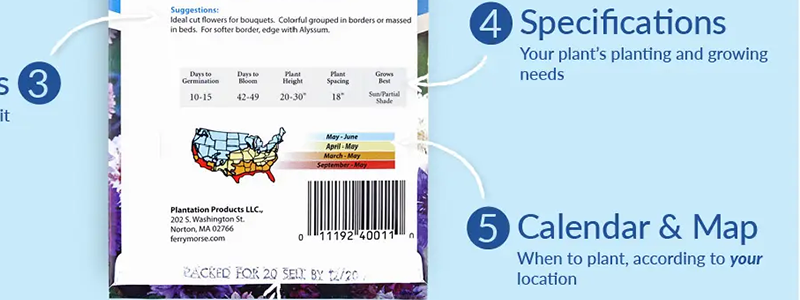
Looking to the back of a Ferry-Morse seed packet to find a plant's growing information and important specifications.
What are the 10 most popularly grown warm-season veggies?
These warm-season vegetables fall on most gardener’s top ten list:
- Basil
- Beans (Garden green beans)
- Carrots
- Corn
- Cucumbers
- Eggplant
- Okra
- Peppers
- Summer squash
- Tomato
What are the 10 most popular cool-season veggies?
- Asparagus
- Beets
- Broccoli
- Brussels Sprouts
- Cauliflower
- Garlic
- Leafy greens
- Lettuce
- Onion
- Potato
What are the easiest vegetables to grow from seed?
Raising vegetables from seed is more relaxing when they’re easy to grow. The chart below lists the easiest vegetables to grow from seed with their requirements.
Note: Spacing requirements may vary by each vegetable’s specific variety on each vegetable’s product page or seed packet.
Cool-season vegetables that are easy to grow
| Vegetable | Nutrient Needs | Moisture | Life cycle | Amount to plant per person (fresh / stored) |
|---|---|---|---|---|
| Broad (fava) beans | Medium / Soil builder | Average | Semi-hardy annual | 4–8 plants (pl.) / 8–10 pl. |
| Brussels sprouts | Heavy | Moist | Hardy biennial | 2–5 pl. / 5–8 pl. |
| Carrots | Light | Moist and frequent | Hardy biennial | 5–10 feet (ft.) / 10-15 ft. |
| Lettuce | Heavy | Moist and frequent | Hardy annual | 5–15 ft. |
| Radish | Heavy | Average | Hardy annual | 3–5 ft. |
| Spinach | Heavy | Average | Hardy annual | 5–10 ft. / 10–15 ft. |
| Swiss chard | Light | Average | Semi-hardy biennial | 3–5 pl. / 8–12 pl. |
Warm-season vegetables that are easy to grow
| Vegetable | Nutrient Needs | Moisture | Life cycle | Amount to plant per person (fresh / stored) |
|---|---|---|---|---|
| Beans | Medium / Soil builder | Average | Tender annual | Lima, bush:
10–15 ft. / 15–20 ft. Lima, pole: 5–6 ft. / 8–10 ft. Snap, bush: 15–20 ft. / 15–20 ft. Snap, pole: 5–6 ft. / 8–10 ft. |
| Cucumbers | Heavy | Moist | Very tender annual | 1–2 hills (hl.) / 3–5 hl. |
| Peppers | Heavy | Average | Very tender perennial | 3–5 pl. / 3–5 pl. |
| Summer squash | Heavy | Average | Very tender annual | 2–3 hl. / 2–3 hl. |
| Tomatoes | Heavy | Moist | Tender annual | 3–5 pl. / 5–10 pl. |
These crop guides from Texas describe the particulars of growing each vegetable. And the best part is your county extension office has similar resources for your region.
Low-maintenance vegetables
Some vegetables grow happily without much intervention beyond the basics. Let’s take a closer look.
Cool-season vegetables that don’t require a lot of TLC include:
- Beets
- Brussels sprouts
- Carrots
- Chard
- Lettuce
- Parsley
- Radishes
The best garden vegetables for an uncomplicated warm-season garden include:
- Zucchini
- Spinach
- Peppers
- Okra
- Beans
- Basil
Tip: Don’t forget about pollinators!
Throw some flowers in the mix to attract pollinators that help your vegetables set fruit. We recommend starting with Butterfly Weed because pollinators and beneficial insects love the nectar produced by its beautiful orange blooms. We’re sure that you’ll love flowers in your garden too!
Sprout positive life changes in your own backyard.
Vegetable gardening can bring positive changes into your life. It’s a healthy, enjoyable, and empowering activity that you can do from home. Now it’s your turn to take the next step by planting your own backyard vegetable garden. Please let us know how you’re doing on social media, and don’t ever hesitate to reach out to us for support!
CLICK HERE TO EXPLORE THE REST OF THE FERRY-MORSE GARDENING BLOG -->


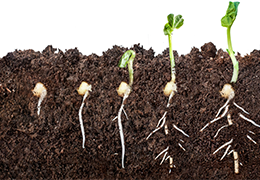

Yes, there are intermediate steps for starting tomatoes from seed. Here are a few pointers: Move seedlings to a larger container when they are 3–4" tall. Thin weaker plants by snipping at the soil line. Don’t lift seedlings by the stem—gently grip a leaf if necessary. Any part of the stem covered with soil will develop roots. Plant the stem up to the lowest set of leaves
to develop strong roots. Fertilize weekly, diluting the strength for seedlings.
Thanks for commenting! We will consider deer and rabbit control for a future article. In the meantime, here are a couple of articles covering that topic: https://ferrymorse.com/blogs/ferry-morse-home-gardening-blog/home-gardening-how-to-identify-and-control-garden-pests; https://www.canr.msu.edu/news/how_to_protect_your_yard_and_garden_from_deer_and_rabbits
Also, seed packets will either list the seed count or fill weight. Learn more here: https://ferrymorse.com/blogs/ferry-morse-home-gardening-blog/how-to-read-seed-packet
Please be sure to advise new gardeners about protecting their plants/crops against deer, rabbits etc. It is so disappointing to grow something and find it eaten up by an animal. They must know how to protect their precious plants so they can enjoy the fruits of their labor. Anyone who has had their plants eaten up will not be willing to spend any more money on growing and you will lose a life long customer.
I have purchased many packets of Ferry-Morse seeds from Lowes. How do I determine how many seeds are in each packet without opening the package? Tis information should be on the outside of the package, but I do not see it.
Ok! I live in Southern California and I’ve got 34 tomato plants started from seed in a Jiffy Tray. Is there an intermediate transplanting step from the tray to a container before I put them in the ground? How tall should the plants be before I take them out of the tray?